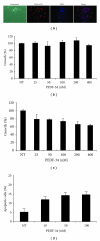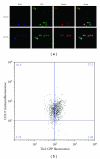A PEDF-derived peptide inhibits retinal neovascularization and blocks mobilization of bone marrow-derived endothelial progenitor cells
- PMID: 21754923
- PMCID: PMC3132462
- DOI: 10.1155/2012/518426
A PEDF-derived peptide inhibits retinal neovascularization and blocks mobilization of bone marrow-derived endothelial progenitor cells
Abstract
Proliferative diabetic retinopathy is characterized by pathological retinal neovascularization, mediated by both angiogenesis (involving mature endothelial cells) and vasculogenesis (involving bone marrow-derived circulating endothelial progenitor cells (EPCs)). Pigment epithelium-derived factor (PEDF) contains an N-terminal 34-amino acid peptide (PEDF-34) that has antiangiogenic properties. Herein, we present a novel finding that PEDF-34 also possesses antivasculogenic activity. In the oxygen-induced retinopathy (OIR) model using transgenic mice that have Tie2 promoter-driven GFP expression, we quantified Tie2GFP(+) cells in bone marrow and peripheral blood by fluorescence-activated cell sorting (FACS). OIR significantly increased the number of circulating Tie2-GFP(+) at P16, correlating with the peak progression of neovascularization. Daily intraperitoneal injections of PEDF-34 into OIR mice decreased the number of Tie2-GFP(+) cells in the circulation at P16 by 65% but did not affect the number of Tie2-GFP(+) cells in the bone marrow. These studies suggest that PEDF-34 attenuates EPC mobilization from the bone marrow into the blood circulation during retinal neovascularization.
Figures







Similar articles
-
Novel Peptide NT/K-CFY Derived from Kringle Structure of Neurotrypsin Inhibits Neovascularization.Curr Eye Res. 2021 Oct;46(10):1551-1558. doi: 10.1080/02713683.2021.1907417. Epub 2021 Apr 19. Curr Eye Res. 2021. PMID: 33870816
-
Overexpression of pigment epithelium-derived factor inhibits retinal inflammation and neovascularization.Am J Pathol. 2011 Feb;178(2):688-98. doi: 10.1016/j.ajpath.2010.10.014. Am J Pathol. 2011. PMID: 21281801 Free PMC article.
-
Antiangiogenic effects and transcriptional regulation of pigment epithelium-derived factor in diabetic retinopathy.Microvasc Res. 2010 Jul;80(1):31-6. doi: 10.1016/j.mvr.2010.02.012. Epub 2010 Feb 26. Microvasc Res. 2010. PMID: 20219495
-
Anti-vasopermeability effects of PEDF in retinal-renal disorders.Curr Mol Med. 2010 Apr;10(3):279-83. doi: 10.2174/156652410791065291. Curr Mol Med. 2010. PMID: 20236056 Review.
-
Role of pigment epithelium-derived factor in stem/progenitor cell-associated neovascularization.J Biomed Biotechnol. 2012;2012:871272. doi: 10.1155/2012/871272. Epub 2012 May 22. J Biomed Biotechnol. 2012. PMID: 22685380 Free PMC article. Review.
Cited by
-
Potential therapeutic effects of pigment epithelium-derived factor for treatment of diabetic retinopathy.Int J Ophthalmol. 2013 Apr 18;6(2):221-7. doi: 10.3980/J.ISSN.2222-3959.2013.02.22. Print 2013. Int J Ophthalmol. 2013. PMID: 23638428 Free PMC article.
-
Bone marrow-derived cells in ocular neovascularization: contribution and mechanisms.Angiogenesis. 2016 Apr;19(2):107-18. doi: 10.1007/s10456-016-9497-6. Epub 2016 Feb 15. Angiogenesis. 2016. PMID: 26880135 Free PMC article. Review.
-
Angiogenic content of microparticles in patients with diabetes and coronary artery disease predicts networks of endothelial dysfunction.Cardiovasc Diabetol. 2022 Feb 2;21(1):17. doi: 10.1186/s12933-022-01449-0. Cardiovasc Diabetol. 2022. PMID: 35109843 Free PMC article.
-
Anti-angiogenic Therapy for Retinal Disease.Handb Exp Pharmacol. 2017;242:271-307. doi: 10.1007/164_2016_78. Handb Exp Pharmacol. 2017. PMID: 27783271 Free PMC article.
-
PEDF in diabetic retinopathy: a protective effect of oxidative stress.J Biomed Biotechnol. 2012;2012:580687. doi: 10.1155/2012/580687. Epub 2012 Apr 10. J Biomed Biotechnol. 2012. PMID: 22570532 Free PMC article.
References
-
- Battegay EJ. Angiogenesis: mechanistic insights, neovascular diseases, and therapeutic prospects. Journal of Molecular Medicine. 1995;73(7):333–346. - PubMed
-
- Bouck N. PEDF: anti-angiogenic guardian of ocular function. Trends in Molecular Medicine. 2002;8(7):330–334. - PubMed
-
- Gao G, Li Y, Zhang D, Gee S, Crosson C, Ma JX. Unbalanced expression of VEGF and PEDF in ischemia-induced retinal neovascularization. FEBS Letters. 2001;489(2-3):270–276. - PubMed
-
- Miller JW, Adamis AP, Aiello LP. Vascular endothelial growth factor in ocular neovascularization and proliferative diabetic retinopathy. Diabetes Metabolism Reviews. 1997;13(1):37–50. - PubMed
-
- Abu El-Asrar AM, Struyf S, Verbeke H, Van Damme J, Geboes K. Circulating bone-marrow-derived endothelial precursor cells contribute to neovascularization in diabetic epiretinal membranes. Acta Ophthalmologica. 2011;89(3):222–228. - PubMed
Publication types
MeSH terms
Substances
Grants and funding
LinkOut - more resources
Full Text Sources
Other Literature Sources
Medical
Miscellaneous
